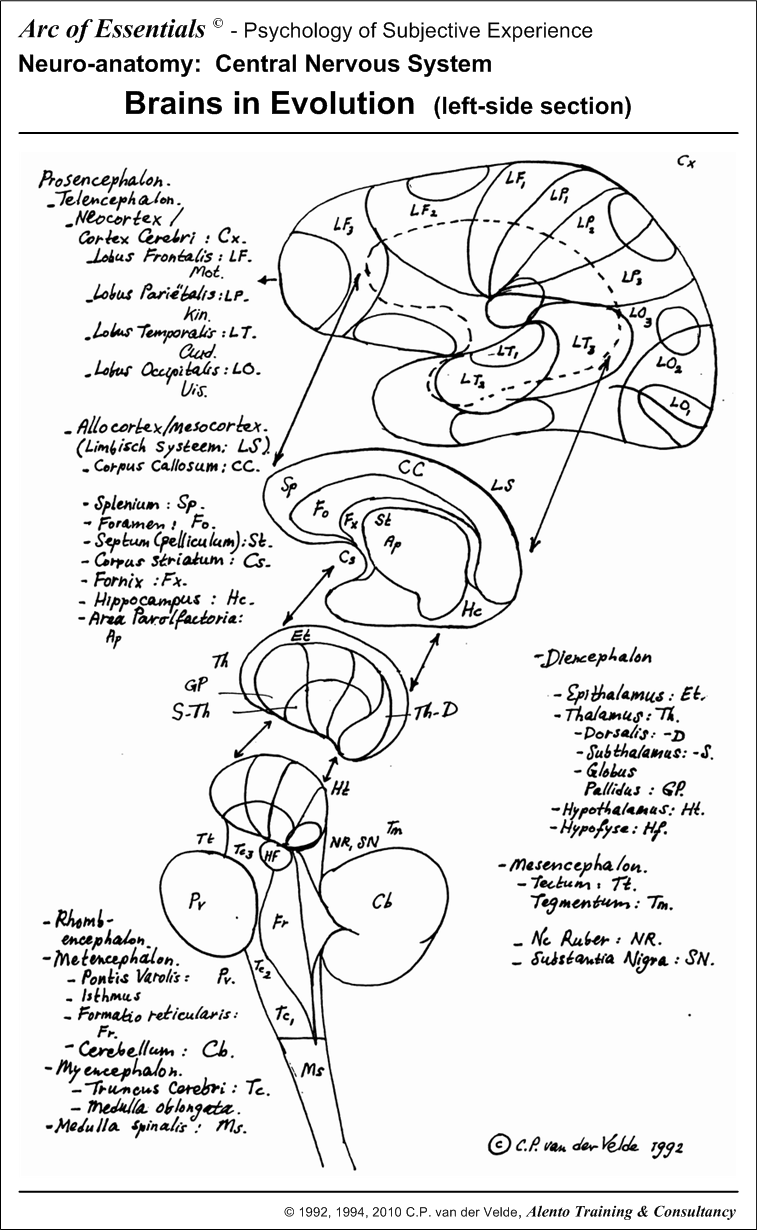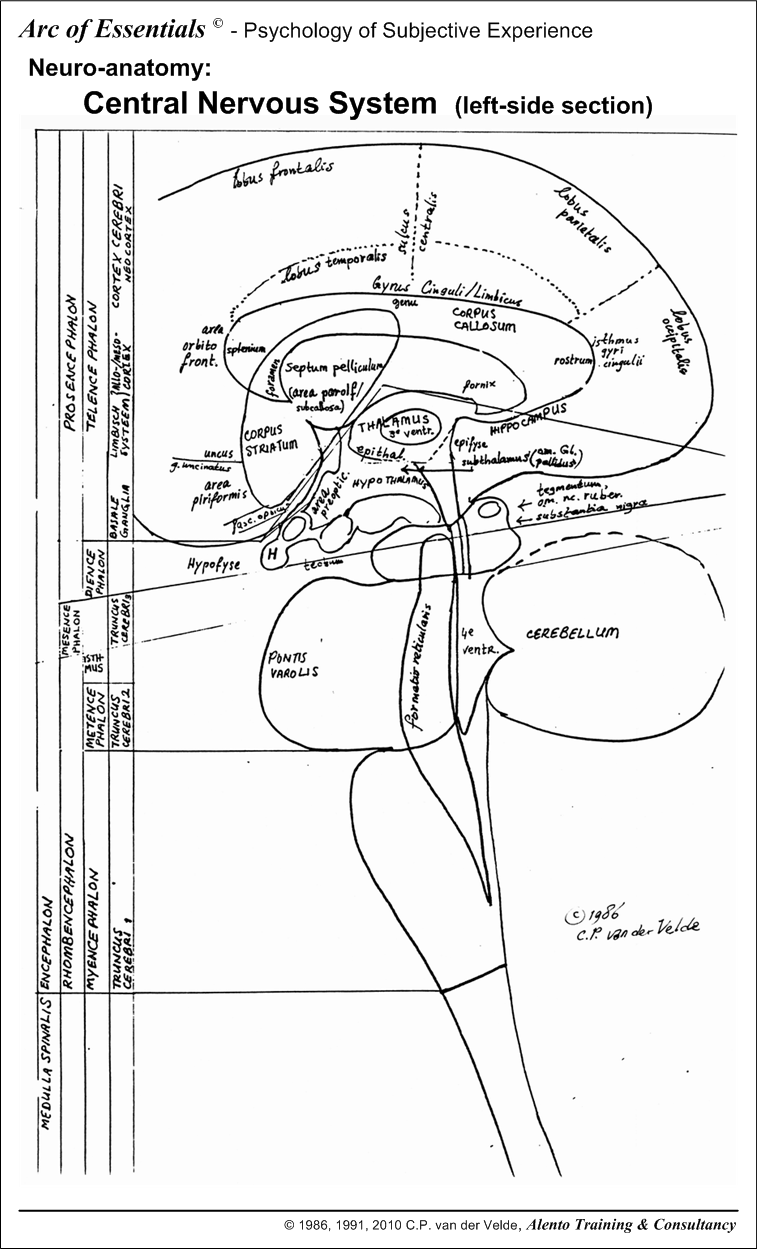Components of
Psychology of Subjective Experience
© :
Consciousness in animals
.. they may feel pain the way you do!
C.P. van der Velde
1.0 : Friday January 22th, 2010 at 17:28 h.
Some interesting facts were mentioned in Posthoorn, a local paper in The Hague, of Nov. 11th 2009: 91 percent of responders feel that suffering of animals is just as serious as that of humans!
They seem to be on the right track regarding strong neuro-psycho-logical evidence.
(1) Neuro-anatomy.
In humans, sense organs, nerve cells, tracts and brain areas for sensation of physical pain (of likewise suffering) are located in the brain stem (truncus cerebri). They belong to the eldest brain parts ('reptile' brains or earlier), and in animals they are basically no different than in humans (or vice versa).
Many animal species, certainly mammals, have neural systems more or less similar in anatomy and functioning, for a rich variety of emotions, located in mid-brains (up to the limbic system).
(2) Cognitive performance.
Whether human information processing is really the most intelligent of living organisms on earth is not easy to decide.
First of all, many animal species show remarkeble intelligent archievements in their natural habitats that men can hardly understand, and even less equal let alone exceed. Especially when it comes to the variety and refinement of certain sensory systems, many animal species easily outperform humans.
Still, comparing to most animal species, humans obviously have more brain capacities for intellectual ('cerebral') performance and achievements.
But is intelligence - of whatever sort or level - really relevant to consciousness?
Complex information processing can also be performed by dull computers, it concerns abstract ordering patterns, and doesn't require consciousness at all. (Complexity is only a logical characteristic, thus of quantitative nature. It may not be computable or even logically decidable, though, but that doesn't make it less quantitative. In itself, it will never pass the line to the area were quality roams).
In general, the level of intelligence as such doesn't change much in the nature and intensity of intense conscious experience, like physical pain, itch, fear of death, etc.. Only through applying some specific 'smart' mental strategies it might, but that would be highly dependent of mind-over-matter causation, which in it's turn would be dependent of consciousness again - rendering the latter superior.
(3) Simultaneous with waking state.
Concerning the ability for consciousness as such, nowhere in the nerve system there is a difference to be found between humans and animals. In fact, the strongest and almost complete neuropsychological correlation of consciousness (NCC) is a specific brain functioning when it is in certain global internal states:
(a) every-day waking state,
(b) conscious or lucid dreams,
(c) special mental states like (not-to-deep) hypnotical trance.
This specific brain functioning arises through certain activity of the Ascending Reticular System,
which is located in the formatio reticularis in the brain stem - which is already found in the most
rudimentary vertibrate ('fish') brains !(b) conscious or lucid dreams,
(c) special mental states like (not-to-deep) hypnotical trance.
NB. See also:
(·) Characteristics van Subjective Consciousness.
In particular:
(·) Characteristics van Subjective Consciousness.
In particular:
(I.1) Non-unique features - that are
neuronal-related:
Non-unique features - that are
neuronal-related: N*B
characteristics.
(I.1.1)
(I.1.2)
('pseudo-physical 'characteristics of consciousness).
Characteristics of neuronal aspects - related to consciousness.
(I.1.2)
Inherent characteristics of consciousness - which are physico-chemical and information-related
('pseudo-physical 'characteristics of consciousness).
(4) Expression of experience.
The main difference appears to be that animals cannot express their conscious experience - of joy, or suffering, or any other subjective quality - - in human language. But of course, they do express pain and joy and many other sensations and emotions - non-verbally!
(5) Contrary to traditional views.
Some religiously engaged persons operate from the principle that animals are created 'after their nature', while humans are created 'after the image of God', which would of course imply an essential difference of cosmic proportions. Indeed, western society has acted from highly anthropocentric views and practices for ages now, and in doing so has been blindly destroying nature, life forms and eco-systems on earth in an ever-accelerating exponential rate, to critical levels by now. However, the neuro-physio- and psycho-logical facts, such as described above, point to the opposite of these assumptions of absolute human supremacy that are essentially arbitrary.
(6) Intrinsic value - urging for justice.
So, if humans have any innate and intrinsic value, e.g. due to their conscious experience, than animals too: not just a market value like objects for production, commerce and consumption (and bad treatment). This suggests fairly solid grounds for animal rights.

|
|
The Brain in Evolution: a rough sketch.
In the course of evolution, early parts of the brain have become superpositioned by newer parts. From bottom to top - and at the same time, from centre core to outer shell - we can discern several evolutionary stages in the brains, corresponding roughly to subsequent parts of the brains: first the 'fish', 'amphibian' and 'reptile brains', then the 'mammal brains', furthermore the 'primate brains' and lately the 'human brains'. The capacity of waking state alertness - which seems to coincide with consciousness - appears to be already present in the lowest parts of the brain stem, which is within the 'fish brains'. |

|
|
Anatomy of the Brain: right-side view.
So far, every picture of the brain's architecture has to be an extreme oversimplification, given the immense complexity of the central nerve system's structure and workings. |
See also:
(·) Theory of Subjective Consciousness
, summary (in English).
(·) Overall view: Features of Subjective Consciousness.
(·) Nested structure: Features of Subjective Consciousness.
(·) Neurophysiology, Biopsychology - General .
(·) Neurophysiology, Biopsychology - Neuro-anatomy and functions.
(·) Neurophysiology, Biopsychology and Consciousness.
(·) Neurophysiology and Consciousness during Dreaming.
(·) Overall view: Features of Subjective Consciousness.
(·) Nested structure: Features of Subjective Consciousness.
Literature
(·) Neurophysiology, Biopsychology - General .
(·) Neurophysiology, Biopsychology - Neuro-anatomy and functions.
(·) Neurophysiology, Biopsychology and Consciousness.
(·) Neurophysiology and Consciousness during Dreaming.